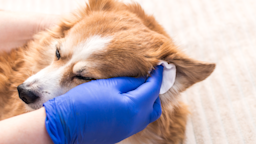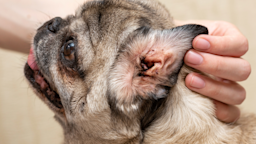Key takeaways:
Clean your cat’s ears if they look dirty. Otherwise, the cat probably doesn’t need it.
Be gentle, and don’t push wax and other debris into the ear canal with a cotton swab.
Take your cat to the veterinarian if their ears look inflamed, your cat is scratching them, or you see a substance that looks like coffee grounds or excessive dark brown wax.
“Oh G.G.!” I say in my playful mama voice. “Earsies!”
“Oh no,” my cat’s dismayed look says when I reach for her pointy ears. “Not this again!”
My G.G., a 15-year-old black cat — the matriarch of my household’s feline tribe — has a chronic, recurring otitis externa (inflammation of the ear) in her right ear. When she is having a flare-up, she will often hold her right ear flap lower than her perky left one, and scratch at the irritated ear with her paws. When I look inside, I see excessive brown wax and built-up guck.
Search and compare options

Although G.G. hates it, groans, and squirms, I need to clean her ears. Sometimes, I squirt in a liquid medication made for pets, then massage the base of her ear for a few seconds to make sure the liquid penetrates her ear canal. If her symptoms get especially bad, I take her to our veterinarian for an exam and a professional cleanout.
My calm, cool, and collected approach to kitty ear care
Independent cats are not known for being cooperative and submissive with their humans. But it’s a good idea to clean your cat’s ears if they look dirty in the outer crevices. Cats’ self-cleaning — done by licking their paws, then stroking their heads — doesn’t always prevent a wax accumulation and keep the ears clean enough.


You can just do a dry cleaning carefully with a cotton swab, or add a deeper wet cleaning with a solution. Your cat may pleasantly surprise you: Cats all have unique personalities, and some are more tolerant than others. Some cats, in fact, seem to enjoy having their ears swabbed.
Case in point: my other cats. Buf-Puf tolerates the twirling swab, albeit grudgingly. Kringle is grumpy and squirmy. As for Victoria, my young black female? Strangely, she seems to enjoy her session of ear cleaning: She closes her eyes, relaxes, and slips into a kitty Zen-like state as I swirl the swab and remove some dark brown wax. I can almost hear Victoria saying, “Aaaaahhhh, yes!’
Learn what to do and what not to do
Before you even think about cleaning your cat’s ears, it doesn’t hurt to do a little research to find out what the experts say about how (and when) to clean a cat’s ears. There is a wrong way to do it.
To be on the safe side, I spoke to my vet about tips on whether, how, and when to clean your cat’s ears. One important ear-cleaning principle: Don’t do it too often.
Read more like this
Explore these related articles, suggested for readers like you.
Here are some do’s and don’ts based on my vet’s advice and my own experience.
Don’t use hydrogen peroxide
You don’t want to irritate a kitty’s ears from overzealous cleaning or put too much moisture in there from a cleansing solution. You also want to use a cleaning solution made for felines — not hydrogen peroxide or products containing alcohol or vinegar.
Don’t stick a cotton swab in your cat’s ear canal
Vets advise us to do the same thing with cat ears as human ears: If you’re using cotton swabs, only swab the outer ear and don’t stick the swab down into the ear canal. (A cotton ball is actually a safer choice.)
In humans, an inserted swab can impact the earwax by the eardrum. In cats, the same thing can happen with wax and other debris, but the impaction is worse because of their L-shaped ear canals. And, like with our own ears, we should be gentle when cleaning the sensitive ear skin.
Go to the vet if you think your cat might have ear mites
Before you clean your cat’s ears, it’s also important to know when your pet might have an ear condition that requires a veterinary visit and medical treatment — in particular, ear mites, which are not life-threatening but extremely maddening for your cat.
The itching and irritation is intense — and contagious to other animals. (Just imagine how we would feel if we had tiny bugs crawling in our ears and feasting on our ear canals — yikes!
The hallmark symptom of ear mites is a dark brown/almost black, crumbly substance in the ears. If the debris looks like coffee grounds, which sometimes include a little bit of blood and pus, it is likely your cat has these parasites, which infest your cat’s outer ear canal. Your cats will also shake their head, scratch at their ears with their paws, and have drooping ear flaps, if they have ear mites.
However, several ear problems can cause similar symptoms, like a yeast overgrowth and otitis externa. One mistake I made was assuming that G.G.’s symptoms — scratching at and folding her ear, and dark brown, crumbly wax — were ear mites. But regardless of the diagnosis, G.G.’s symptoms required a vet exam.
My tips for coaxing cats into cooperating
Now, how do I get a fussy cat to submit to ear cleaning? Here’s my six-step approach for a successful cleaning.
1. Be calm
I speak soothingly to my cat and gently scruff the back of the neck to keep kitty from escaping.
2. Use gentle restraint
With a finger on my scruffing hand, I fold back the ear flap to expose the inside.
3. Use one hand to hold and the other to clean
Then, with my other hand, I swab out the crevices at the top of the ear canal.
4. Have your supplies within reach
If I am putting a liquid cleanser or medication in kitty’s ear, I scruff with one hand, then put the bottle tip at the opening of the ear canal and squirt.
5. Keep some towels handy
Then, for a few seconds, I rub at the base of the ear to make sure the liquid penetrates the ear canal. Rubbing in the liquid is an important step, because when you put any liquid in your cat’s ears, they will shake their head hard afterwards. Be prepared to get sprayed by the excess liquid!
6. Use treats as positive reinforcement
After accomplishing anything that is unpleasant for your cats, give them a treat. A food treat, extra affection, or a session with a laser pointer soothes them, and purrhaps scores you brownie points that will make the next attempt easier.

Why trust our experts?





















